Christianity in India
| languages | |
| Names in native languages include Eesai, Kristhava, Masihi-Qaum, Nasrani |
| Part of a series on |
| Christianity in India |
|---|
 |
| Christianity by country |
|---|
 |
|
|
The
Following
Among North India's oldest Christians are those of Bettiah, Bihar, formed in the early 1700s.[26][27] The
Christians were involved in the
Ancient period
St. Bartholomew
St. Thomas
According to the tradition of
Another church tradition concerning the birth of Jesus holds that Gaspar, one of the three Biblical Magi, travelled from India to find the infant Jesus along with Melchior of Persia and Balthazar of Arabia.[60]
An early 3rd-century AD Syriac work known as the Acts of Thomas[61] connects the tradition of the Apostle Thomas' Indian ministry with two kings, one in the north and the other in the south. The year of his arrival is widely disputed due to lack of credible records.[62] According to one of the legends in the Acts of Thomas, Thomas was at first reluctant to accept this mission, but Jesus over-ruled him by ordering circumstances so compelling that he was forced to accompany an Indian merchant, Abbanes, to his native place in northwest India, where he found himself in the service of the Indo-Parthian king, Gondophares. The apostle's ministry reputedly resulted in many conversions throughout this northern kingdom, including the king and his brother.[61]
The Acts of Thomas identifies his second mission in India with a kingdom ruled by a certain King named Mahadwa belonging to a 1st-century dynasty in southern India.
Although little is known of the immediate growth of the church in the northwestern regions of India,
-
Saint Thomas Christians or Syrian Christians of ancient days from an old painting.
-
Mar Thoma Syro-Malabar Catholic Church, in Muziris present-day Kodungaloor, is believed to be the first Christian church built in India, circa 52 A. D.
-
Saint Thomas the Apostle
-
Altar of the St. Mary's Church in Kottayam flanked by two Saint Thomas crosses from the 7th century AD on either side. The crosses pre-date the church which was built in 1550 AD.
-
St. Mary'sThiruvithamcode Arappally of Malankara Orthodox Syrian Church in Kanniyakumari,Tamil Nadu is believed to have been founded by St. Thomas the Apostlein 63 AD.
-
Nasranichurch established in 999 AD.
-
St Geevargeese Mar Gregorios, an Oriental Orthodox Saint, in Kerala.
-
Tomb of the Saint Moran Mor Ignatius Elias Third (the only Universal Syrian Orthodox Patriarch to be buried in India) at Manjinikara, Kerala.
4th-century missions
India had a flourishing trade with
The Chronicle of Seert describes an evangelical mission to India by Bishop David of Basra around the year 300,[68] who reportedly made many conversions,[69] and it has been speculated that his mission took in areas of southern India.[70]
Medieval period
The
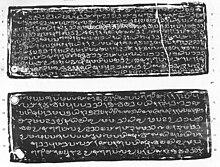
Other references to
The French or Catalan
Modern period

Portuguese efforts to Catholicize Saint Thomas Christians
Historically, this community was organised as the
The death of the last
Following the synod, the Indian Church was governed by Portuguese prelates. They were generally unwilling to respect the integrity of the local church. This resulted in disaffection which led to a general revolt in 1653 known as the "Coonan Cross Oath". Under the leadership of Archdeacon Thomas, Nazranis around Cochin gathered at Mattancherry church on Friday, 24 January 1653 (M.E. 828 Makaram 3) and made an oath that is known as the Great Oath of Bent Cross. There are various versions about the wording of oath, one version being that the oath was directed against the Portuguese, another that it was directed against Jesuits, yet another version that it was directed against the authority of Church of Rome.[93] Those who were not able to touch the cross tied ropes on the cross, held the rope in their hands and made the oath. Because of the weight it is believed by the followers that the cross bent a little and so it is known as "Oath of the bent cross" (Coonen Kurisu Sathyam). This demanded administrative autonomy for the local church.
A few months, later Archdeacon Thomas was ordained as bishop by twelve priests with the title
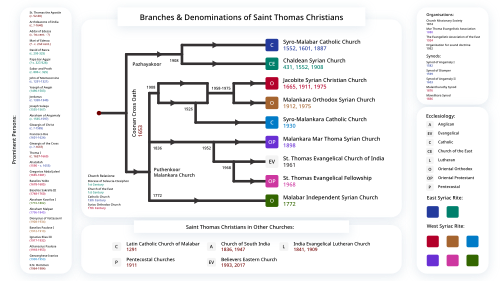
The Pazhayakūr comprise the present day
Arrival of Europeans
In 1453, the
The South Indian coastal areas around Kanyakumari were known for pearl fisheries ruled by the Paravars. From 1527, the Paravars, being threatened by Arab fleets offshore who were supported Zamorin of Calicut,[106] sought the protection of the Portuguese who had moved into the area. The protection was granted on the condition that the leaders were immediately baptised as Christians and that they would encourage their people also to convert to Christianity. The Portuguese in turn wanted to gain a strategic foothold and control of the pearl fisheries. The deal was agreed and some months later 20,000 Paravars were baptised en masse, and by 1537 the entire community had declared itself to be Christian. The Portuguese navy destroyed the Arab fleet at Vedalai on 27 June 1538.[107][106]
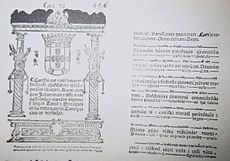
In the 16th century, the proselytisation of Asia was linked to the
During the second expedition, the Portuguese fleet comprising 13 ships and 18 priests, under Captain
In the beginning of the 16th century, the whole of the east was under the jurisdiction of the
The first converts to Christianity in Goa were native Goan women who married Portuguese men that arrived with

The Portuguese government supported the missionaries. At the same time many
In 1557,
The
The
The
In
With the decline of the Portuguese power, other colonial powers namely the Dutch and British gained influence, paving the way for the arrival of Protestantism.
Arrival of Protestant missions
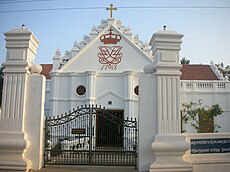
Beginning about 1700 Protestant missionaries began working throughout India, leading to the establishment of different Christian communities across the Indian Subcontinent.
German Lutherans and Basel mission
The first Protestant missionaries to set foot in India were two
German missionary Johann Phillip Fabricius, who arrived in South India in 1740, published the first Tamil to English dictionary and refined the Tamil Bible translation.[126]
Christian Friedrich Schwarz was a prominent German Lutheran missionary who arrived in India in 1750. His mission was instrumental in the conversion of many people from Tamil Nadu to Lutheranism. He died in Tamil Nadu and was buried in St.Peter's Church at Thanjavur, Tamil Nadu.[127][128][129]
Hermann Gundert a German missionary, scholar, and linguist, as well as the maternal grandfather of German novelist and Nobel laureate Hermann Hesse was a missionary in the South Indian state of Kerala and was instrumental in compiling a Malayalam grammar book, Malayalabhaasha Vyakaranam (1859), in which he developed and constructed the grammar currently spoken by the Malayalis, published a Malayalam-English dictionary (1872), and contributed to work on Bible translations into Malayalam.[130][131]
Eugen Liebendörfer was the first German missionary doctor in India as part of the Basel Mission. He built hospitals in Kerala and Karnataka.[132]
Another Basel Missionary Ferdinand Kittel worked in South Indian state of Karnataka in places such as Mangalore, Madikeri and Dharwad in Karnataka. He is renowned for his studies of the Kannada language and for producing a Kannada-English dictionary of about 70,000 words in 1894. He also composed numerous Kannada poems.[133][134][135]
Another Lutheran German missionary to South Indian state of Kerala was Volbrecht Nagel, he was a missionary to the Malabar coast of India. Initially associated with the Evangelical Lutheran Church, he later joined the Open Brethren, and is remembered now as a pioneer of the Kerala Brethren movement.[137]
William Carey and the Baptists

In 1793,
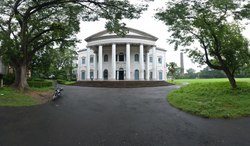
Other missions
The London Missionary Society was the first Protestant mission in Andhra Pradesh which established its station at Visakhapatnam in 1805.[140] Anthony Norris Groves, a Plymouth Brethren missionary arrived in 1833. He worked in the Godavari delta area until his death in 1852. John Christian Frederick Heyer was the first Lutheran missionary in the region of Andhra Pradesh. He founded the Guntur Mission in 1842. Supported initially by the Pennsylvania Ministerium, and later by the Foreign Mission Board of the General Synod, Heyer was also encouraged and assisted by British government officials. He established a number of hospitals and a network of schools throughout the Guntur region.[141]
The Church Missionary Society (CMS), a mission society working with the Anglican Communion,[142] began sending missionaries to India and established mission stations at Chennai (Madras) and Bengal, then in 1816 at Travancore.[143] The CMS Mission to India expanded in the following years. The successors of the Protestant church missions are the Church of South India and the Church of North India.[142]
During the Bettiah Raj of Bihar, the ethnoreligious community of Bettiah Christians was established in India in the 17th century by Christian missionaries belonging to the Order of Friars Minor Capuchin, a Roman Catholic religious order.[145] The Capuchins were personally invited to establish the Bettiah Christian Mission by Maharaja Dhurup Singh after the Italian Capuchin priest Joseph Mary Bernini treated his ill wife. Pope Benedict XIV, on 1 May 1742, approved the appointment of the Capuchins at the Bettiah Fort in a letter to Maharaja Dhurup Singh.[146]
Many upper-class Bengalis converted to Christianity during the
During the 19th century, several American Baptist missionaries evangelised in the northeastern parts of India. In 1876, Dr. E. W. Clark first went to live in a Naga village, four years after his Assamese helper, Godhula, baptised the first Naga converts. Rev. and Mrs. A.F. Merrill arrived in India in 1928 and worked in the southeast section of the Garo Hills.[148] Rev. and Mrs. M.J. Chance spent most of the years between 1950 and 1956 at Golaghat working with the Naga and Garo tribes.[149] Even today the heaviest concentrations of Christians in India continue to be in the Northeast among the Nagas, Khasis, Kukis, and Mizos.[150]
Role in the Indian independence movement
Indian Christians were involved even at early stages of the nationalist movement in colonial India, both in the Indian National Congress and the wider Indian independence movement:[36]
Indian Christian involvement in the early stages of the nationalist movement is also reflected in the high levels of participation in the activities of the Indian National Congress. During the period from its inception up until about 1892 all the evidence suggests that Indian Christians enthusiastically supported the National Congress and attended its annual meetings. For example, according to the official Congress report, there were 607 registered delegates at the Madras meeting of 1887; thirty-five were Christians and, of these, seven were Eurasians and fifteen were Indian Christians. Indian Christians alone made up 2.5 per cent of the total attendance, in spite of the fact that Christians accounted for less than 0.79 per cent of the population. The Indian Christian community was also well represented at the next four sessions of the Congress. The proportion of Indian Christian delegates remained very much higher than their proportion in the population, in spite of the fact that meetings were sometimes held in cities such as Allahabad and Nagpur, far removed from the main centres of Christian population.[36]
The
Art and architecture
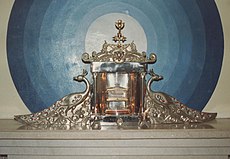
There are a large number of items of artistic and architectural significance in the religious and domestic life of Indian Christians.
The following artistic elements predate European Christianity and form an integral part of the religious art and architecture of the Saint Thomas Christians:
- The open-air granite (rock) cross called the Nasrani Sthamba
- Kodimaram (Dwajasthamba) or flag-staff made of Kerala's famed teak wood and often enclosed in copper hoses or paras
- The rock Deepasthamba or lampstand.[151]
After the arrival of
Indian Christian architecture during the
-
Manarcad Church is one of the oldest churches as well as a popular pilgrim site in India.
-
Interior of the St. Aloysius Chapel in Mangalore, an example of Indo-Baroque.
-
Interior of the CNI Cathedral Church of Redemption, New Delhi, a fine example of the Indo-Saracenic architectureal style.
-
Built in 1562, Se Cathedral is an example of the Portuguese-Manueline style of architecture.[156][157]
-
St. Paul's CNI Cathedral, Calcutta is one of the finest examples of Gothic Revival architecture in India.[158]
-
Infant Jesus Cathedral in Kollam city is an example of modern church architecture in India.
-
Church of South India Cathedral of St. George, Chennai is an example of the Neoclassical style .[161]
-
TheAll Saints Cathedral, Allahabad illuminated at night.[163]
-
Vadayaparambu Mar Bahanans Church, built in the traditional style of the Malankara Orthodox Church.
-
Renaissance Revival style in India.[165]
Kerala Christians have a unique tradition of photographing funerals.[166]
Culture

While Christians in India do not share one common culture, their cultures for the most part tend to be a blend of Indian, Syrian and European cultures. It differs from one region to another depending on several factors such as the prevailing
As a result of the
Contemporary
Religion plays a significant role in the daily life of Indian Christians, India ranks 15 among countries with based on
Christian weddings in India conform to the traditional
Demographics
Relative size of Christian traditions in India, according to
The 2001 census of India recorded 24,080,016 Christians in the country, representing 2.34 per cent of the population.
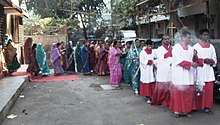
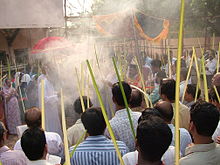

Population by denomination
In 2011, Pew reported 18,860,000 Protestants, 10,570,000 Catholics, 2,370,000 Oriental Orthodox and 50,000 other Christians in India.[2] Other sources estimate the total number of Protestants throughout the country in several hundreds of denominations at 45 million (4.5 crore).[184][185] Several sources estimate Catholic population in India at over 17 million (1.7 crore)[186][187] The largest single denomination is the Roman Catholic Church.[188] Anglicans within the united Church of North India and Church of South India, constitute the second largest group at over 5 million (50 lakh).[189][190]
The
Most Protestant denominations are represented in India, as a result of missionary activities throughout the country, such as the
The Open Brethren movement is also significantly represented in India. The main Brethren grouping is known as the Indian Brethren (with a following estimated at somewhere between 449,550[201] and 1,000,000), of which the Kerala Brethren are a significant subset. The closely related Assemblies Jehovah Shammah have around 310,000 adults and children in fellowship as of 2010.[201] They are often considered part of the wider Brethren movement, although they were founded by an indigenous evangelist (Bakht Singh) and developed independently of the older Indian Brethren movement, which originated from missionary endeavours.
Pentecostalism is also a rapidly growing movement in India. The major Pentecostal churches in India are the Indian Pentecostal Church of God,[202] the Assemblies of God, The Pentecostal Mission,[203][204] the New Apostolic Church with 1,448,209 members,[202] the New Life Fellowship Association with 480,000 members, the Manna Full Gospel Churches with 275,000 members,[202] and the Evangelical Church of India with 250,000 members.[205]
See main article: List of Christian denominations in India.
| Church name | Population | Orientation |
|---|---|---|
| Latin Church ("Roman Catholic" Church) | 11,800,000 | Catholic, Latin Church |
| Malankara Orthodox Syrian Church | 1,600,000[55] | Oriental Orthodox , West Syriac Rite
|
Jacobite Syrian Orthodox Church
|
1,200,000[55] | Oriental Orthodox , West Syriac Rite
|
Malankara Mar Thoma Syrian Church
|
1,100,000[195] | Independent and Eastern Protestant Christian, Protestant West Syriac Rite |
Syro-Malabar Catholic Church
|
4,000,000[206] | Catholic, East Syriac Rite |
| Syro-Malankara Catholic Church | 410,000[207] | Catholic, West Syriac Rite |
| Malabar Independent Syrian Church | 20,000 | Independent, West Syriac Rite (follows Oriental Orthodox faith) |
| Chaldean Syrian Church | 35,000 | Church of the East, East Syriac |
| Nagaland Baptist Church Council | 687,442 | Baptist |
| St. Thomas Evangelical Church of India | 35,000 | Episcopalian Protestant |
| Church of South India | 4,000,000 | Anglican (United and uniting )
|
| Church of North India | 2,100,000+ | Anglican (United and uniting )
|
| Methodist Church in India | 648,000 | Protestant |
India Pentecostal Church of God
|
2,600,000 | Protestant Evangelical Pentecostal ( IPC )
|
Assemblies of God in India
|
5,000,000[citation needed] | Protestant Evangelical Pentecostal ( Assemblies of God in India )
|
| United Pentecostal Church in India | 105,000[208] | Protestant Evangelical Pentecostal (United Pentecostal Church in India) |
| The Pentecostal Mission | 700,000 | Protestant |
Baptist
|
2,991,276[209] | Protestant (List of Baptist denominations in India) |
| Assemblies Jehovah Shammah | 310,000[201] | Protestant (Plymouth Brethren) |
Lutheran
|
4,220,178[197][210] | Protestant List of Lutheran Denominations Worldwide |
| Jeypore Evangelical Lutheran Church (JELC) | 250,000 | Protestant Lutheran |
| Orissa Baptist Evangelistic Crusade (OBEC) | 650,000 | Protestant Baptist |
| Indian Brethren | 449,550[201] to 1,000,000 | Protestant (Kerala Brethren) |
| Presbyterian Church of India | 1,452,780[211][212] | Protestant (Reformed) |
| Reformed Presbyterian Church North East India | 15,000 | Protestant (Reformed) |
| Reformed Presbyterian Church of India | 10,000 | Protestant (Reformed) |
| Evangelical Church of Maraland | 30,000 | Protestant (Reformed) |
| Congregational Church in India | 5,500 | Protestant (Reformed) |
| Council of Reformed Churches of India | 200,000 | Protestant (Reformed) |
| Hindustani Covenant Church | 16,600 | Protestant |
| Evangelical Church | 250,000 | Protestant |
| New Apostolic Church[202] | 1,448,209 | Protestant |
| Pentecostal Maranatha Gospel Church | 12,000 | Protestant |
| New Life Fellowship Association[202] | 480,000 | Protestant |
| Sharon Fellowship Church[202] | 50,000 | Protestant |
| Manna Full Gospel Churches[202] | 275,000 | Protestant |
| Philadelphia Fellowship Church of India[202] | 200,000 | Protestant |
| Seventh-day Adventist Church | 1,560,000[213] | Protestant/Restorationism |
| Unitarian Union of Northeast India | 10,000 | Unitarian |
| Jehovah's Witnesses | 42,566[214] | Restorationism |
| The Church of Jesus Christ of Latter-day Saints | 14,528[215] | Latter Day Saints |
| Christian Revival Church | 21,447[216] | Full Gospel in faith, Charismatic in worship, Pentecostal in Movement and Holistic Evangelical in Ministry |
| Mennonite Brethren Church | 103,000[217] | Protestant (Reformed) |
| Community of Christ | 15,000+ | Latter Day Saints |
Population by region and group

Christianity is the predominant religion in the North East states of Nagaland, Mizoram Meghalaya, and Manipur, and has substantial populations in the states of Arunachal Pradesh, Assam, Tripura, Andhra Pradesh, Karnataka, Kerala, Tamil Nadu, Goa and Andaman Nicobar Islands. [218]
A 2015 study estimates some 40,000 Christian believers from a Muslim background in the country, most of them belonging to Protestantism.[219]
The census of India provides us with the official numbers for Christian population in India. The Indian census has been recorded every ten years since 1871 and has always included religion (along with population, race, rural distribution, and occupation, among others).[220] The most recently published census is from 2011.[221] Subsequent estimates from 2013, 2015, 2017 and 2019 are also considered reliable.[222]
| States | Christian population | Percentage (%) | Status |
|---|---|---|---|
| Kerala | 6,141,269 | 18.38 | "Significant" |
| Meghalaya | 2,213,027 | 74.59 | "Majority" |
| Nagaland | 1,739,651 | 87.93 | "Majority" |
| Manipur | 1,179,043 | 41.29 | "Plurality" |
| Mizoram | 956,331 | 87.16 | "Majority" |
| Arunachal Pradesh | 418,732 | 30.26 | "Plurality" |
| Goa | 366,130 | 25.10 | "Significant" |
The native majority of Goa is Christian. According to the 1909 statistics in the Catholic Encyclopedia, the total Christian population in Portuguese controlled Goa was 293,628 out of a total population of 365,291 (80.33%), partly because of centuries long persecution of Hindus and Muslims in Goa.[224] Due to emigration of Christianized Goans (mostly Goan Catholics) from Goa to cosmopolitan cities in India (Mumbai, Bangalore, etc.) and to foreign countries, as well as back migration of Hindus and Muslims to Goa from other states of India since the 20th century, the demographics of Goa have been returning to the historical figures. Less than 50% of Indian residents in Goa are Goan Christians.[225]

| State/UT | Total population | Christian (%) | Christian population |
|---|---|---|---|
| 1,210,854,977 | 2.30 | 27,819,588 | |
| Kerala | 33,406,061 | 18.38 | 6,141,269 |
| Tamil Nadu | 72,147,030 | 6.12 | 4,418,331 |
| Meghalaya | 2,966,889 | 74.59 | 2,213,027 |
| Nagaland | 1,978,502 | 87.93 | 1,739,651 |
| Jharkhand | 32,988,134 | 4.30 | 1,418,608 |
| Manipur | 2,855,794 | 41.29 | 1,179,043 |
| Assam | 31,205,576 | 3.74 | 1,165,867 |
| Odisha | 41,974,218 | 2.77 | 1,161,708 |
| Karnataka | 61,095,297 | 1.87 | 1,142,647 |
Andhra Pradesh
|
84,580,777 | 1.34 | 1,129,784 |
| Maharashtra | 112,374,333 | 0.96 | 1,080,073 |
| Mizoram | 1,097,206 | 87.16 | 956,331 |
| West Bengal | 91,276,115 | 0.72 | 658,618 |
| Chhattisgarh | 25,545,198 | 1.92 | 490,542 |
| Arunachal Pradesh | 1,383,727 | 30.26 | 418,732 |
| Goa | 1,458,545 | 25.10 | 366,130 |
| Uttar Pradesh | 199,812,341 | 0.18 | 356,448 |
| Punjab | 27,743,338 | 1.26 | 348,230 |
| Gujarat | 60,439,692 | 0.52 | 316,178 |
| Madhya Pradesh | 72,626,809 | 0.29 | 213,282 |
| Tripura | 3,673,917 | 4.35 | 159,882 |
| Delhi | 16,787,941 | 0.87 | 146,093 |
| Bihar | 104,099,452 | 0.12 | 129,247 |
| Rajasthan | 68,548,437 | 0.14 | 96,430 |
| Andaman and Nicobar Islands | 380,581 | 21.28 | 80,984 |
| Puducherry | 1,247,953 | 6.29 | 78,550 |
Sikkim
|
610,577 | 9.91 | 60,522 |
| Haryana | 25,351,462 | 0.20 | 50,353 |
Uttarakhand
|
10,086,292 | 0.37 | 37,781 |
| Jammu and Kashmir | 12,541,302 | 0.28 | 35,631 |
| Himachal Pradesh | 6,864,602 | 0.18 | 12,646 |
| Chandigarh | 1,055,450 | 0.83 | 8,720 |
| Dadra and Nagar Haveli | 343,709 | 1.49 | 5,113 |
| Daman and Diu | 243,247 | 1.16 | 2,820 |
| Lakshadweep | 64,473 | 0.49 | 317 |
| Religion | Scheduled caste |
Scheduled tribe |
Other Backward Class | Forward caste |
|---|---|---|---|---|
| Buddhism | 89.50% | 7.40% | 0.4% | 2.7% |
| Sikhism | 30.70% | 0.90% | 22.4% | 46.1% |
| Hinduism | 22.20% | 9.10% | 42.8% | 26% |
| Christianity | 9.00% | 32.80% | 24.8% | 33.3% |
| Islam | 0.80% | 0.50% | 39.2% | 59.5% |
Conflicts and controversies
Hindu–Christian conflict
The arrival of European colonialists brought about large-scale missionary activity in
During the 1998 attacks on Christians in southeastern Gujarat, the Human Rights Watch reported that from 25 December 1988 to 3 January 1999, at least 20 prayer halls were damaged or burnt down and Christian institutions were attacked in the Dangs district, and its surrounding districts and at least 25 villages had reported incidents of burning and damages to prayer halls all over Gujarat.[230][231]
On 22 January 1999, an Australian missionary
In 2007, 19 churches were burned by Hindu right-wingers in Odisha following conflicts between Hindus and Christians regarding Christmas celebrations in the Kandhamal district.[236]
In 2008, there was again violence against Christians, particularly in the state of
A program or movement with its roots in
India is number 10 on Open Doors' 2022 World Watch List, an annual ranking of the fifty countries where Christians face the most extreme persecution.[246]
Muslim–Christian conflict
The relationship between Muslims and Christians in India has also been occasionally turbulent. With the advent of European colonialism in India throughout the 16th, 17th and 18th centuries, Christians were systematically persecuted in certain Muslim-ruled kingdoms in India, particularly the actions by
The Bakur Manuscript reports Tippu Sultan as having said:[248]
All Musalmans should unite together, considering the annihilation of infidels as a sacred duty, and labour to the utmost of their power, to accomplish that subject.
Soon after the Treaty of Mangalore in 1784, Tipu gained control of South Canara.[249] He issued orders to seize the Christians in Canara, confiscate their estates,[250] and deport them to Seringapatam, the capital of his empire, via the Jamalabad-fort route.[251] However, there were no priests among the captives. Together with Fr Miranda, all the 21 arrested priests were issued orders of expulsion to Goa, fined Rs 200,000, and threatened with death by hanging if they ever returned.[248]
Tipu ordered the destruction of twenty-seven Catholic churches[
An instigating factor that helped spark the
Historian
Muslims in India who convert to Christianity are considered apostates and subject to harassment, intimidation, and attacks by Muslims.[256][257] In Jammu and Kashmir, a Christian convert and missionary named Bashir Tantray was killed, allegedly by militant Islamists in 2006.[258][unreliable source?]
List of Christian communities in India
Christian communities
- Anglo-Indian people
- Bengali Christians
- Bettiah Christians
- Bombay East Indian Catholics
- Dalit Christians
- Goan Catholics
- Karwari Catholics
- Knanaya Christians
- Latin Catholics of Malabar
- Mangalorean Christians
- Marathi Christians
- Meitei Christians
- Protestants in India
- Punjabi Christians
- Reddy Catholics
- St Thomas Christians
- Tamil Christians
- Telugu Christian
Christianity by state
- Christianity in Arunachal Pradesh
- Christianity in Assam
- Christianity in Bihar
- Christianity in Chhattisgarh
- Christianity in Delhi
- Christianity in Goa
- Christianity in Gujarat
- Christianity in Jharkhand
- Christianity in Karnataka
- Christianity in Kerala
- Christianity in Madhya Pradesh
- Christianity in Maharashtra
- Christianity in Manipur
- Christianity in Meghalaya
- Christianity in Mizoram
- Christianity in Nagaland
- Christianity in Odisha
- Christianity in Punjab
- Christianity in Tamil Nadu
- Christianity in Tripura
- Christianity in Uttar Pradesh
- Christianity in West Bengal
Notable Indian Christians
See also
- Catholic Church in India
- Church of India, Burma and Ceylon
- Ancient Christianity in Indian subcontinent
- Anti-Christian violence in India
- Anti-Christian violence in Karnataka
- Caste system among Indian Christians
- Graham Staines
- Koswad
- List of notable Indian Christians
- List of cathedrals in India
- List of Saints from India
- List of basilicas in India
- List of Catholic missionaries in India
- List of Protestant missionaries in India
- Christian seminaries and theological colleges in India
- History of Pentecostalism in India
- Indian Christian Day
- Jesus in India
- History of the Jews in India
- Latin Catholics of Malabar
- Sikhism in India
- Buddhism in India
References
Citations
- ^ a b "India's population at 1.21 billion; Hindus 79.8%, Muslims 14.2%". Business Standard India. 26 August 2015. Archived from the original on 24 April 2021. Retrieved 18 February 2021.
- ^ a b c Hackett, Conrad (December 2011). "Global Christianity A Report on the Size and Distribution of the World's Christian Population" (PDF). Pew–Templeton global religious futures project. pp. 19, 27, 57, 60, 75, 83, 90, 119. Archived (PDF) from the original on 1 February 2021. Retrieved 24 April 2021.
Estimated 2010 Christian Population 31,850,000 (pages 19, 60, 75) Protestant 18,860,000 Catholic 10,570,000 Orthodox 2,370,000 Others 50,000 (pp. 27, 83)
- ^ ISBN 978-0-8028-2417-2.
- St Thomas Mount.
- ^ "The Surprisingly Early History of Christianity in India". Archived from the original on 20 February 2016. Retrieved 26 May 2019.
- ^ "About Thomas The Apostle". sthhoma.com. Archived from the original on 8 February 2011. Retrieved 26 June 2020.
- ISBN 9781087965710.
- ^ OCLC 1237836.
- ^ ISBN 0-8028-2402-1.
It is generally agreed that Aramaic was the common language of Israel in the first century AD. Jesus and his disciples spoke the Galilean dialect, which was distinguished from that of Jerusalem (Matt. 26:73)
- ^ a b "Aramaic language". Encyclopædia Britannica. Retrieved 5 August 2023.
- ^ "Benedict XVI, General Audience, St Peter's Square: Thomas the twin". w2.vatican.va. 27 September 2006. Retrieved 5 August 2023.
- ISBN 965-278-179-7– via University Press of New England.
- ^ Suresh K Sharma, Usha Sharma. Cultural and Religious Heritage of India: Christianity.
The earliest historical evidence, however, regarding the existence of a Church in South India dates from the sixth century AD
- ^ "The Surprisingly Early History of Christianity in India". Archived from the original on 20 February 2016. Retrieved 26 May 2019.
- ^ Machado 1999, pp. 94–96
- ^ Salomon, H. P. and Sassoon, I. S. D., in Saraiva, Antonio Jose. The Marrano Factory. The Portuguese Inquisition and Its New Christians, 1536–1765 (Brill, 2001), pp. 345–7.
- ^ "'Goa Inquisition was most merciless and cruel'". Rediff.com. 14 September 2005. Retrieved 17 May 2016.
- OCLC 3296297.
- ^ "Goa Inquisition". The New Indian Express. Archived from the original on 18 November 2015. Retrieved 17 May 2016.
- ISBN 9788170224976. Retrieved 30 January 2014.
- ^ Langford Louro, Michele; Spodek, Howard (2007). "India in the World; the World in India 1450-1770". Association for Asian Studies. Retrieved 4 January 2024.
The Portuguese also sought to convert Indians to Roman Catholicism. Until 1540 the pace was slow and erratic. With the arrival in India of the Catholic Counter-Reformation and its Jesuit troops, however, 'intolerance became the theme.' The Portuguese destroyed all of the Hindu temples in Goa, their Indian Ocean capital, and many in other settlements as well. 'Most Hindu ceremonies were forbidden, including marriage and cremation.' In 1560, the Portuguese instituted the Inquisition, and by 1600 two-thirds of the population of the city of Goa were Christians. Many of the newly converted Christians nevertheless remained quite conscious of their caste position in the Hindu hierarchy. It was not unusual for a person to identify himself as a Goan Christian Saraswat Brahmin.
- ISBN 978-90-474-0086-8.
- ^ "Christian Impact on India, History of". www.encyclopedia.com. Archived from the original on 26 January 2021. Retrieved 11 January 2022.
- ^ "Christianity hasn't failed in India. Conversion isn't its only goal". 12 September 2020. Archived from the original on 26 September 2021. Retrieved 11 September 2021.
- ^ "The Work of Pioneer Missionaries" (PDF). Archived (PDF) from the original on 4 March 2016. Retrieved 9 September 2020.
- JSTOR 43953933.
- JSTOR 44148177.
- ^ "History". Church of South India. 2010. Archived from the original on 11 August 2020. Retrieved 22 August 2020.
Being the largest Protestant church in India, the CSI celebrates her life with Indian culture and spirituality and she also raises her voice for the voiceless on matters of justice, peace and integrity of creation.
- ^ "History". Church of South India. 2010. Archived from the original on 14 February 2021. Retrieved 22 August 2020.
The Church of South India is the result of the union of churches of varying traditions Anglican, Methodist, Congregational, Presbyterian, and Reformed. It was inaugurated in September 1947, after protracted negotiation among the churches concerned. Organized into 22 dioceses, each under the spiritual supervision of a bishop, the church as a whole is governed by a synod, which elects a moderator (presiding bishop) every 2 years. Episcopacy is thus combined with Synodical government, and the church explicitly recognizes that Episcopal, Presbyterian, and congregational elements are all necessary for the church's life.
- ISBN 978-1-63087-744-6.
The Church of South India created a polity that recognized Episcopal, Presbyterian, and Congregational elements and developed a book of worship that bridged the liturgical traditions that came into this new church. It set up a plan by which existing ministries were accepted while including processes which would lead to the time, a generation later, when all ministers would have been ordained by bishops in apostolic succession. The Church of South India was important as a prototype for a new American church because two factors had come together: the cross-confessional nature of its constituent parts and the intention to be, in effect, the Protestant Christian presence in communities all across the southern territories of its nation.
- ^ IDOC International. IDOC-North America. 1971. p. 85.
...churches that would combine the episcopal, presbyterian and congregational forms of church polity, and would accept the historic episcopate without committing the church to any particular theological interpretation of episcopacy. This is essentially what has been done both in the Church of South India and the Church of North India.
- ^ "Church of North India". World Methodist Council. 9 November 2019. Archived from the original on 27 June 2020. Retrieved 25 June 2020.
The Church of North India is a united church which came into being as the result of a union of six churches on 29th November 1970. The six churches were: The Council of the Baptist Churches in Northern India, The Church of the Brethren in India; The Disciples of Christ; The Church of India (formerly known as the Church of India, Pakistan, Burma and Ceylon); The Methodist Church (British and Australian Conferences); The United Church of Northern India. ... The Church of North India is a full member of the World Council of Churches, the Christian Conference of Asia, the Council for World Mission, the Anglican Consultative Council, the World Methodist Council and the World Alliance of Reformed Churches.
- S2CID 242239030.
- ^ Center, Pew Research (21 September 2021). "3. Religious demography of Indian states and territories". Pew Research Center's Religion & Public Life Project. Retrieved 4 January 2024.
- ^ ISBN 978-0-8386-1021-3.
- ^ .
- ^ Pinto, Ambrose (19 August 2017). "Christian Contribution to the Freedom Struggle". Mainstream. LV (35).
- ^ "Brutality and persecution drive Indian Christians underground". The Times of India. Archived from the original on 29 December 2021. Retrieved 7 April 2022.
- ^ "From Thomas the Apostle to Crypto Christians". 11 April 2014. Archived from the original on 7 April 2022. Retrieved 7 April 2022.
- ^ "Arrests, Beatings and Secret Prayers: Inside the Persecution of India's Christians". The New York Times. 22 December 2021.
- ^ "Arrests, beatings and secret prayers: Inside the persecution of India's Christians". 24 December 2021. Archived from the original on 7 April 2022. Retrieved 7 April 2022.
- ^ "India: Attack on Indian revival meeting sends Christians underground | IIRF". Archived from the original on 30 December 2020. Retrieved 7 April 2022.
- ^ "Hindu extremists threaten to kill Christians in India if they 'utter the name of Christ'". September 2015. Archived from the original on 2 September 2015.
- ^ "India Accelerates Forced Conversions | FSSPX News". Archived from the original on 22 February 2024.
- ^ "Christians face conversion threat in riot-hit Indian state - UCA News". Archived from the original on 24 May 2023.
- ^ "'Misuse' of PESA Act in Ghar Wapsi of Chhattisgarh Tribal Christians: Report". 21 February 2023. Archived from the original on 22 February 2023.
- ^ "No Country for Religious Converts". Archived from the original on 18 July 2023.
- ^ "As another Christmas arrives, Hindu extremists are targeting Indian Christians - Washington Examiner". 25 December 2022. Archived from the original on 22 February 2024.
- ^ Butler & Burns 1998, p. 232.
- ISBN 0-85229-633-9.
- ISBN 9781087913766.
- ^ Stephen Neill, A History of Christianity in India: The Beginnings to AD 1707 (2004). p 29
- OCLC 56405161.
- OCLC 255155413.
- ^ a b c d e Fahlbusch 2008, p. 285.
- ^ a b c d Stephen Andrew Missick. "Mar Thoma: The Apostolic Foundation of the Assyrian Church and the Christians of St. Thomas in India" (PDF). Journal of Assyrian Academic Studies. Archived from the original (PDF) on 27 February 2008. Retrieved 19 September 2007.
- ISBN 81-7495-258-6.
- ^ a b Eusebius of Caesarea, Historia Ecclesiastica5. 9–10. Pantaenus, who was known by Clement of Alexandria (Eusebius Historia Ecclesiastica 5.11.1–2; 6.13.2) and Origen (Eusebius, Historia Ecclesiastica 6.14.8), was certainly a historical person.
- ISBN 9780275973612.
- ^ "Magi biblical figures". Encyclopædia Britannica. Retrieved 10 March 2024.
- ^ a b c d A. E. Medlycott, India and The Apostle Thomas, pp. 18–71; M. R. James, Apocryphal New Testament, pp. 364–436; A. E. Medlycott, India and The Apostle Thomas, pp. 1–17, 213–97; Eusebius, History, chapter 4:30; J. N. Farquhar, The Apostle Thomas in North India, chapter 4:30; V. A. Smith, Early History of India, p. 235; Brown 1956, pp. 49–59
- ISBN 1-59333-180-0.
- ISBN 978-1-925612-63-9. Retrieved 2 September 2021.
- ISBN 978-1-000-22821-2. Retrieved 2 September 2021.
- ^ D'Souza, Ornella (23 December 2018). "Mumbai's oldest church – St Thomas Cathedral to celebrate its three-hundredth anniversary on Christmas Day". DNA India. Archived from the original on 23 April 2021. Retrieved 23 April 2021.
- ^ Neill, A History of Christianity in India: The Beginnings to AD 1707 (2004). p 29
- ^ K.S. Latourette, A History of the Expansion of Christianity, 7 vols., London, 1940–1949
- ^ Baum & Winkler 2003, p. 53
- ^ Missick, Stephen Andrew (2000). "Mar Thoma: The Apostolic Foundation of the Assyrian Church and the Christians of St. Thomas in India" (PDF). Journal of Assyrian Academic Studies. XIV (2): 33–61. Archived (PDF) from the original on 4 March 2009. Retrieved 2 March 2009.
- ^ Neill, A History of Christianity in India: The Beginnings to AD 1707 (2004). p 41
- ^ ISBN 978-0199575831.
- ISBN 9781138899018.
- ^ Fahlbusch 2008, p. 286.
- ISBN 978-93-80607-01-6.
- ^ Syrian Christians of Kerala- SG Pothen- page 32-33 (1970)
- ^ Manimekalai, by Merchant Prince Shattan, Gatha 27
- ^ Anglo Saxon Chronicle Part II, 750–919 AD
- ^ Marco Polo. The Book of Travels. page 287.
- ^ "Milestones in the History of the Diocese of Quilon". Archived from the original on 20 June 2017. Retrieved 25 April 2017.
- ^ a b "The greate prelates who shaped the history of diocese of quilon". Quilon Diocese. Archived from the original on 18 June 2006. Retrieved 17 January 2008.
- ^ "Gazetteers Of The Bombay Presidency – Thana". Archived from the original on 10 November 2010. Retrieved 23 July 2010.
- ^ "East Indians (the indigenous Catholic inhabitants of Bombay, Salsette and Bassein)" (PDF). The East Indian Community. Archived (PDF) from the original on 10 February 2012. Retrieved 2 March 2008.
- ISBN 81-7821-008-8.
- ISBN 81-7495-258-6.
- ^ Baum & Winkler 2003, p. 52.
- ^ "How did Timur change the history of the world - DailyHistory.org". dailyhistory.org. Archived from the original on 5 March 2022. Retrieved 5 March 2022.
- ^ "10 Terrors of the Tyrant Tamerlane". Listverse. 15 January 2018. Archived from the original on 6 January 2021. Retrieved 8 June 2021.
- ^ Frykenberg, p. 111.
- ^ "Christians of Saint Thomas" Archived 28 March 2015 at the Wayback Machine. Encyclopædia Britannica. Retrieved 9 February 2010.
- ^ Frykenberg, pp. 134–136.
- ^ Frykenberg 2008, p. 93; Wilmshurst 2000, p. 343.
- ^ a b Synod of Diamper Archived 12 November 2020 at the Wayback Machine on Synod of Diamper Church website.
- ^ Census of India (1961: Kerala. Office of the Registrar General. 1965. p. 111.
There are various versions about the wording of swearing, one version being that it was directed against the Portuguese, another that it was directed against Jesuits, yet another that it was directed against the authority of church of Rome
- ^ "Synod of Diamper." Encyclopædia Britannica. Encyclopædia Britannica Online. Encyclopædia Britannica Inc., 2011. Web. 23 December 2011.
- ^ For the Acts and Decrees of the Synod cf. Michael Geddes, "A Short History of the Church of Malabar Together with the Synod of Diamper &c." London, 1694;Repr. in George Menachery, Ed., Indian Church History Classics, Vol.1, Ollur 1998, pp.33–112
- ^ Addai and Mari, Liturgy of. Cross, F. L., ed. The Oxford Dictionary of the Christian Church. Oxford University Press. 2005
- ^ Thomas Joseph , “Malankara Syriac Orthodox Church,” in Malankara Syriac Orthodox Church, edited by Sebastian P. Brock, Aaron M. Butts, George A. Kiraz and Lucas Van Rompay, https://gedsh.bethmardutho.org/Malankara-Syriac-Orthodox-Church Archived 1 August 2021 at the Wayback Machine.
- ^ "Kerala Syrian Christian, Thomas the Apostle in India, the tomb of the Apostles, Persian Church, Syond of Diamper – Coonan Cross Oath, Subsequent divisions and the Nasrani People". 13 February 2007. Archived from the original on 22 May 2021. Retrieved 8 June 2021.
- ^ Sebastian P. Brock , “Thomas Christians,” in Thomas Christians, edited by Sebastian P. Brock, Aaron M. Butts, George A. Kiraz and Lucas Van Rompay, https://gedsh.bethmardutho.org/Thomas-Christians Archived 7 March 2022 at the Wayback Machine.
- ^ "Byzantine-Ottoman Wars: Fall of Constantinople and spurring "age of discovery"". Archived from the original on 4 June 2015. Retrieved 18 August 2012.
- ^ "Overview of Age of Exploration". Archived from the original on 9 July 2012. Retrieved 18 August 2012.
- ^ Brown 1956.
- ^ Podipara, Placid J. (1970) "The Thomas Christians". London: Darton, Longman and Tidd, 1970. (is a readable and exhaustive study of the St. Thomas Christians.)
- ^ "Christianity in India". M.B. Herald, Vol. 35, No. 9. Archived from the original on 9 March 2008. Retrieved 13 March 2008.
- ISBN 0-04-950005-8.
- ^ a b c Hastings 2000, pp. 166–168.
- ^ Frykenberg 2008, pp. 137–138.
- ^ Frykenberg 2008, p. 139.
- ^ Georg Schurhammer, and M. Joseph Costelloe, Francis Xavier: His Life, His Times. Vol. 3: Indonesia & India, 1545–1549 (1980).
- ^ Bayly p. 326
- ^ Kenneth Scott Latourette, A history of expansion of Christianity. vol 3. Three centuries of advance: AD 1500-AD 1800 (1939) pp 247–84.
- ^ Britannica CD 97, S.V "Gama, Vasco da "
- ^ a b "Factfile: Roman Catholics around the world". BBC News. 29 January 2012. Archived from the original on 29 January 2012.
- ^ "Vasco da Gama collection". University of Michigan Library. Archived from the original on 16 October 2007.
- OCLC 554054.
- ^ S2CID 145210059. Archived from the originalon 20 August 2019. Retrieved 9 September 2017.
- ^ Crowley, Roger (2015). Conquerors: How Portugal Forged the First Global Empire. London: Faber & Faber.
- ISBN 978-81-7022-259-0.
- ^ Couto, Maria Aurora. Goa. Penguin Books. pp. 109–121, 128–131.
- ^ Glen, Ames. Portugal and its empire, 1250–1800. Trent University Press. pp. 12–15.
- ISBN 9789004120808.
- ISBN 9789004120808.
- ISBN 978-0-8264-6074-5.
- ^ a b Machado 1999, p. 104
- ^ a b The Legacy that Ziegenbalg Left (by). S. Muthiah (The Hindu http://www.hinduonnet.com/thehindu/mag/2006/07/02/stories/2006070200200500.htm Archived 7 April 2008 at the Wayback Machine)
- ^ Frykenberg, Robert Eric.
- ^ Pearson, H.N. (1855). The life of Christian F. Swartz : Missionary at Travancore. A.D. 1750-1798. London: Seeley, Jackon, Halliday and B. Seeley.
- (PDF) from the original on 23 February 2022. Retrieved 26 May 2022.
- ^ One or more of the preceding sentences incorporates text from a publication now in the public domain: Chisholm, Hugh, ed. (1911). "Schwarz, Christian Friedrich". Encyclopædia Britannica. Vol. 24 (11th ed.). Cambridge University Press. p. 389.
- ^ Herman Gundert | Kerala Press Academy Archived 14 May 2013 at the Wayback Machine. Pressacademy.org. Retrieved 28 July 2013.
- ISBN 978-81-7835-370-8. Archivedfrom the original on 27 May 2016. Retrieved 15 November 2015.
This Bungalow in Tellicherry ... was the residence of Dr. Herman Gundert .He lived here for 20 years
- hdl:10603/132374. Archivedfrom the original on 23 April 2023. Retrieved 26 May 2022.
- ^ Manjulakshi, L.; Shripad Bhat (9 September 2005). "Kannada Dialect Dictionaries and Dictionaries in Subregional Languages of Karnataka". Language in India. 5. Archived from the original on 17 February 2012. Retrieved 27 September 2007.
- ^ Rizvi, Aliyeh (9 August 2015). "Resident Rendezvoyeur: Against all odds". No. Bangalore. Bangalore Mirror. Bangalore Mirror Bureau. Archived from the original on 6 July 2017. Retrieved 12 August 2015.
- ^ Journal of the Karnatak University: Humanities: Volume 19 Karnatak University - 1975 "He was also involved in the work of the revision of the Kannada Bible. But his magnum opus was the school dictionary English- Kannada Shala Nighantu, which saw the light of the day in 1876. Though William Reeve (missionary) compiled and published ..."
- ^ "Miscellany - Early years of Kannada journalism". Deccan Herald. 28 July 2015. Archived from the original on 8 May 2017. Retrieved 22 November 2016.
- ^ "The Story of Volbrecht Nagel". 24 July 2010. Archived from the original on 29 September 2022. Retrieved 22 May 2021.
- ^ Vishal Mangalwadi and Ruth Mangalwadi, The Legacy of William Carey: A Model for the Transformation of a Culture (1999) excerpt Archived 23 January 2017 at the Wayback Machine
- ^ Sujit Sivasundaram, "'A Christian Benares' Orientalism, science and the Serampore Mission of Bengal." Indian Economic & Social History Review 44.2 (2007): 111–145. online Archived 22 January 2017 at the Wayback Machine
- ^ "Canadian Baptist mission work among women in Andhra, India, 1874–1924: Baptist women evolved a role for themselves in an otherwise male-dominated mission enterprise and a patriarchal Telugu society". Archived from the original on 2 April 2015. Retrieved 5 March 2015.
- ^ "John C F Heyer, Missionary". Archived from the original on 4 October 2018. Retrieved 5 March 2015.
- ^ a b Keen, Rosemary. "Church Missionary Society Archive". Adam Matthew Publications. Archived from the original on 20 January 2022. Retrieved 29 January 2017.
- ^ "The Church Missionary Atlas (India)". Adam Matthew Digital. 1896. pp. 95–156. Archived from the original on 18 October 2020. Retrieved 19 October 2015.
- ^ "William Carey". Archived from the original on 7 December 2010.
- ^ John, Jose Kalapura (2000). Proceedings of the Indian History Congress, Vol. 61. Indian History Congress. pp. 1011–1022.
- ^ "Diocese of Bettiah". Union of Catholic Asian News. Archived from the original on 16 November 2020. Retrieved 15 November 2020.
- ^ Marina Ngursangzeli Behera, "William Carey and the British East India Company" American Baptist Quarterly (Winter 2010) 29.1–2 (2010): 6–18.
- ^ "Old Fulton NY Post Cards By Tom Tryniski" (PDF). fultonhistory.com. Archived (PDF) from the original on 29 February 2012. Retrieved 5 March 2022.
- ^ American Baptist Foreign Mission Society, Tour of Assam, 1960
- ^ "Census of India: Religion". 2001 Census of India. Ministry of Home Affairs, Govt. of india. Archived from the original on 15 March 2018. Retrieved 4 November 2013.
- ^ a b c d "Art Architecture India Christian Kerala Syrian Christianity". Archived from the original on 2 April 2015. Retrieved 5 March 2015.
- ^ Singh et al. 2007, p. 69.
- ^ Das, 98
- ^ "Monuments in Chennai, Monuments of Chennai India, Monuments Tour in Chennai, Chennai Monuments Tours, Travel to Chennai Monuments, Chennai Monuments Holidays". Archived from the original on 7 May 2010. Retrieved 22 July 2010.
- ^ "Gemmakonrad's Travel Blog: Mamallapuram, India – April 25, 2006". TravelPod. Archived from the original on 10 April 2010. Retrieved 5 March 2015.
- ^ Issar 1997, p. 27
- ^ Pereira 2000, p. 190
- ^ "The story of the fifth Bishop of Calcutta". The Telegraph. Kolkota. Archived from the original on 25 September 2020. Retrieved 4 June 2020.
- ^ "Indian Philately Digest : News : April 2014". India Post. Archived from the original on 4 June 2020. Retrieved 4 June 2020.
- ^ "200 years of Bangalore's oldest Christian landmark". India Today. Archived from the original on 13 April 2019. Retrieved 4 June 2020.
- ^ "200 Years of the Iconic St George's Cathedral in Chennai". NDTV.com. Archived from the original on 4 June 2020. Retrieved 4 June 2020.
- ^ "Medak Cathedral Church | District Medak, Government of Telangana | India". Govt. of Telangana. Archived from the original on 4 June 2020. Retrieved 4 June 2020.
- ^ "All About All Saint's Cathedral". allahabad.gov.in. Official website of Allahabad, Uttar Pradesh, India. Archived from the original on 6 May 2020. Retrieved 4 June 2020.
- ^ "Afghan church gets a glass makeover". The Indian Express. 5 July 2004. Archived from the original on 23 April 2021. Retrieved 23 April 2021.
- ^ Kapoor, Cheena (8 March 2017). "St James, Delhi's oldest church set to get a facelift". DNA India. Archived from the original on 23 April 2021. Retrieved 23 April 2021.
- ^ Sebastian, Meryl (26 March 2023). "The photo tradition at Christian funerals in Kerala". BBC News. BBC. Archived from the original on 27 March 2023. Retrieved 27 March 2023.
- ^ a b "The Culture of Kerala". Archived from the original on 16 June 2013.
- ^ "Welcome to Indian Christianity". Archived from the original on 6 October 1999. Retrieved 5 March 2015.
- ISBN 978-0521359405. Archivedfrom the original on 24 March 2023. Retrieved 5 March 2015.
- ^ "Goan People, Culture and Festivals in Goa: India Line Travel". Archived from the original on 25 May 2017. Retrieved 5 March 2015.
- ^ da Silva Gracias, Fatima (1997). "The Impact of Portuguese Culture in Goa: A Myth or Reality". In Charles J. Borges (ed.). Goa and Portugal: Their Cultural Links. New Delhi: Concept Publishing Company. pp. 41–51.
- ^ "History". Official website of Diocese of Manglore. Retrieved 26 November 2013.[permanent dead link]
- ^ "EN-DANÉS _____ foro creado por Blanca Ortiz – Tranquebar: a Danish town in India – Viajes y sitios". Archived from the original on 27 March 2010.
- ^ "The Book of Common Prayer". Archived from the original on 17 July 2017. Retrieved 5 March 2015.
- ^ "Indian Christians Treat Their Women Better, Sex Ratio Highest". 25 December 2007. Archived from the original on 3 July 2017. Retrieved 5 March 2015.
- ^ "Global Perspective: India's Christian identity". Archived from the original on 4 March 2016. Retrieved 5 March 2015.
- ^ Origin of Goa Carnival Archived 19 June 2010 at the Wayback Machine
- ^ "Anglo-Indians mark Christmas with charity". The Times of India. India. 26 December 2008. Archived from the original on 11 August 2011.
- ^ "Mangalorean.com – Mangalore News". Archived from the original on 8 December 2014. Retrieved 5 March 2015.
- ^ "Harvest Festival". St. John's Church, Bangalore. Archived from the original on 2 December 2013. Retrieved 26 November 2013.
- ^ "Christian Wedding". Archived from the original on 4 July 2017. Retrieved 5 March 2015.
- from the original on 7 July 2022. Retrieved 15 August 2022.
- ^ a b "Population by religious communities". Archived from the original on 6 January 2019. Retrieved 5 March 2015.
- ISBN 978-0-8160-6983-5.
- ^ "Number of Christians in China and India". Lausanne Movement. 8 July 2011. Archived from the original on 13 June 2020. Retrieved 13 June 2020.
- ^ "Factfile: Roman Catholics around the world". 1 April 2005. Archived from the original on 15 January 2018. Retrieved 13 June 2020.
- ^ "Statistics by Country, by Percentage Catholic [Catholic-Hierarchy]". catholic-hierarchy.org. Archived from the original on 1 July 2020. Retrieved 13 June 2020.
- ISBN 978-0-85598-495-3.
- ISBN 978-1-4982-0216-9.
- ISBN 978-0-334-04043-9.
- from the original on 11 June 2021. Retrieved 15 June 2021.
- from the original on 20 April 2021. Retrieved 15 June 2021.
- ^ "Recapitulation of Statistics". The Syro-Malankara Catholic Major Archiepiscopal Church. Archived from the original on 3 March 2016.
- ISBN 9781317052296.
- ^ a b "Overview – MAR THOMA SYRIAN CHURCH OF MALABAR". Archived from the original on 3 December 2015. Retrieved 5 March 2015.
- ^ "Adherents.com". Archived from the original on 21 September 2003. Retrieved 5 March 2015.
{{cite web}}: CS1 maint: unfit URL (link) - ^ a b "Adherents.com". Archived from the original on 28 October 2014. Retrieved 5 March 2015.
{{cite web}}: CS1 maint: unfit URL (link) - ^ "GBGM Feature". Archived from the original on 16 February 2009.
- ^ "Baptist World Alliance – Statistics". Archived from the original on 18 April 2008.
- ^ "Indian Christianity". Archived from the original on 15 October 2014. Retrieved 5 March 2015.
- ^ a b c d Mandryk, Jason (2010), Operation World, Biblica Publishing, p. 408
- ^ a b c d e f g h "PENTECOSTALISM IN INDIA: AN OVERVIEW Stanley M. Burgess 2001" (PDF). Archived from the original (PDF) on 4 November 2013. Retrieved 2 November 2013.
- ^ "Critique Of Pentecostal Mission By A Friendly Evangelical" (PDF). Archived from the original (PDF) on 8 April 2008.
- ^ "The Witness of New Christian Movements in India Roger E. Hedlund 7 Aug 2004" (PDF). Archived (PDF) from the original on 6 November 2013. Retrieved 2 November 2013.
- ^ "Adherents.com". Archived from the original on 2 April 2015. Retrieved 5 March 2015.
{{cite web}}: CS1 maint: unfit URL (link) - ^ "Population Statistics and Demography of Saint Thomas Christians, Churches with historical references". Nasranis. 13 February 2007. Archived from the original on 6 August 2017. Retrieved 5 March 2015.
- ^ "Population Statistics". 13 February 2007. Archived from the original on 6 August 2017. Retrieved 23 November 2009.
- ^ "United Pentecostal Church of North East India". December 2018. Retrieved 19 October 2023.
- ^ "Baptist World Alliance – Statistics". bwanet.org. Archived from the original on 27 September 2019. Retrieved 19 July 2020.
- ^ "India-The Lutheran World Federation". lutheranworld.org. Archived from the original on 18 April 2018. Retrieved 19 July 2020.
- ^ "Member Church Feature: Presbyterian Church of India". Council for World Mission. 27 April 2018. Archived from the original on 1 October 2020. Retrieved 19 July 2020.
- ^ "The Official Site of The Presbyterian Church of India (PCI)". pcishillong.org. Archived from the original on 14 November 2017. Retrieved 19 July 2020.
- ^ "International Resources for Latter-day Saints". Cumorah.com. Archived from the original on 5 June 2013. Retrieved 9 June 2013.
- ^ 2016 Yearbook of Jehovah's Witnesses, p.182
- ^ "Statistics and Church Facts | Total Church Membership". newsroom.churchofjesuschrist.org. Archived from the original on 16 April 2021. Retrieved 12 March 2021.
- ^ Arunachal Pradesh Christian Revival Church Council (APCRCC), Annual Report as on 31 December 2015
- ISBN 978-1926599113.
- ^ "Census India 2011". Archived from the original on 22 September 2020. Retrieved 28 August 2015.
- ^ Johnstone, Patrick; Miller, Duane (2015). "Believers in Christ from a Muslim Background: A Global Census". International Journal of Research in Religion. 11 (10): 14. Archived from the original on 13 March 2021. Retrieved 20 November 2015.
- S2CID 141590947.
- ^ "Census of India – History of Indian Census". censusindia.gov.in. Archived from the original on 19 August 2011. Retrieved 11 April 2020.
- .
- ^ "India Census 2011". www.censusindia.gov.in. Archived from the original on 25 August 2015. Retrieved 5 March 2022.
- ^ Ernest Hull (1909). "Archdiocese of Goa". Catholic Encyclopedia, Vol. 6. New York: Robert Appleton Company.
- ^ Menezes, Vivek (15 May 2021). "Who belongs to Goa? This question resurfaces as the State battles the raging pandemic". The Hindu. Archived from the original on 2 June 2021. Retrieved 3 September 2022.
- ^ "Census of India – Religious Composition". Government of India, Ministry of Home Affairs. Archived from the original on 13 September 2015. Retrieved 27 August 2015.
- ^ "Social, Economic and Educational Status of the Muslim Community of India" (PDF). minorityaffairs.gov.in. Archived (PDF) from the original on 3 May 2022. Retrieved 19 May 2022.
- ^ D'Souza, Anthony X. (1913). . In Herbermann, Charles (ed.). Catholic Encyclopedia. New York: Robert Appleton Company.
- ^ Goa and Portugal: Their Cultural Links, p. 35, by Charles J. Borges, Helmut Feldmann, year = 1997
- ^ "Politics by Other Means: Attacks Against Christians in India". Refworld. Archived from the original on 22 March 2020. Retrieved 11 April 2020.
- ^ "Bearing the cross: Recent attacks against Christians worrisome". Hindustan Times. 15 March 2015. Archived from the original on 7 August 2015. Retrieved 11 April 2020.
- ^ "Where's Dara Singh?". outlookindia.com. Archived from the original on 11 January 2018. Retrieved 11 January 2018.
- ^ "Remembering Graham Staines, 18 Years After His Murder". The Quint. Archived from the original on 4 November 2020. Retrieved 11 January 2018.
- ^ "US rights report slams India for anti-Christian violence". Express India. 27 February 1999. Archived from the original on 16 February 2008. Retrieved 17 December 2007.
- ^ a b Bareth, Narayan (23 February 2005). "State to bar religious conversion". BBC News. Archived from the original on 27 January 2011. Retrieved 23 June 2011.
- ^ "India: Stop Hindu-Christian Violence in Orissa". Human Rights Watch. 30 December 2007. Archived from the original on 4 November 2013. Retrieved 2 November 2013.
- ^ "Anti-Christian Violence on the Rise in India". Human Rights Watch. 1 October 1999. Archived from the original on 25 September 2013. Retrieved 2 November 2013.
- ^ "Violence in India Is Fueled by Religious and Economic Divide". The New York Times. Tiangia, India. 3 September 2008. Archived from the original on 1 November 2016. Retrieved 24 February 2017.
- ^ "BJP MLA convicted in Kandhamal riots case". The Hindu. Chennai, India. 9 September 2010. Archived from the original on 4 November 2014. Retrieved 5 December 2016.
- ^ Akkara, Anto (15 August 2016). "Indian Supreme Court: State Response to Anti-Christian Mob Violence 'Inadequate'". Gleanings | ChristianityToday.com. Archived from the original on 24 September 2016. Retrieved 5 December 2016.
- ^ Vinay Lal. "Anti-Christian Violence in India". Manas: India and Its Neighbors. UCLA College of Letters and Science. Archived from the original on 2 October 2002.
- ^ "Anti-Christian Violence on the Rise in India". Human Rights Watch. 29 September 1999. Archived from the original on 26 April 2015. Retrieved 4 December 2016.
- ^ "Attacks on Christians across India". Human Rights Watch. Archived from the original on 18 April 2020. Retrieved 11 January 2018.
- .
- ^ "Ghar wapsi only way to end terror says BJP leader". Hindustan Times. 25 December 2014. Archived from the original on 29 December 2014.
- ^ "India is number 10 on the World Watch List". Archived from the original on 24 June 2022. Retrieved 24 June 2022.
- Daijiworld Media Pvt Ltd Mangalore. Archived from the originalon 10 May 2006. Retrieved 29 February 2008.
- ^ a b c Sarasvati's Children, Joe Lobo
- ^ Forrest 1887, pp. 314–316
- ^ The Gentleman's Magazine 1833, p. M1 388
- ^ "Christianity in Mangalore". Diocese of Mangalore. Archived from the original on 9 July 2010. Retrieved 30 July 2008.
- ^ John B. Monteiro. "Monti Fest Originated at Farangipet – 240 Years Ago!". Daijiworld Media Pvt Ltd Mangalore. Archived from the original on 8 February 2012. Retrieved 28 April 2009.
- ISBN 978-0-14-100554-6.
- ^ a b c d Dalrymple 2009, pp. 22–23
- ^ a b Dalrymple 2009, p. 153
- ^ Gheddo, Piero (25 May 2012). "Indian Kashmir, 'unknown arsonists' set fire to a Catholic church". Asia News. Archived from the original on 21 February 2020. Retrieved 4 November 2013.
- ^ Carvalho, Nirmala. "Indian Kashmir, two Christians arrested on false charges of forced conversions". Asia News. Archived from the original on 21 June 2019. Retrieved 11 July 2016.
- ^ Christian convert from Islam shot dead in Kashmir Archived 17 October 2007 at the Wayback Machine
Bibliography
- ISBN 978-0521891035.
- ISBN 978-1134430192.
- Beckerlegge, Gwilym (1997). "Professor Friedrich Max Müller and the Missionary Cause". In Wolfe, John (ed.). Religion in Victorian Britain. Vol. V – Culture and Empire. ISBN 0-7190-5184-3.
- Bernard, K. L. (1995). Flashes of Kerala History. Cochin: Victory Press.
- Bowring, Lewin (1893). Haidar Ali and Tipu Sultan and the struggle with the Musalman powers of the south (1974 ed.). Delhi: Adabiyat-I Delli. Archived from the original on 17 August 2011. Retrieved 11 July 2016.
- Brown, Leslie W. (1956). The Indian Christians of St Thomas: An Account of the Ancient Syrian Church of Malabar. Cambridge: Cambridge University Press.
- Butler, Alban; Burns, Paul (1998). Butler's Lives of the Saints: August. A&C Black. ISBN 978-0-86012-257-9.
- Dalrymple, William (2009). The Last Mughal: The Fall of Delhi, 1857. Bloomsbury Publishing. ISBN 978-1-4088-0688-3.
- Dutta, Sutapa (2017). British Women Missionaries in Bengal, 1793–1861. UK: Anthem Press. ISBN 978-1-78308-726-6
- Fahlbusch, Erwin (2008). "Syrian Orthodox Churches in India". The Encyclopedia of Christianity, Volume 5. Grand Rapids, MI: Wm. B. Eerdmans. ISBN 978-0-8028-2417-2.
- ISBN 3337278663.
- Frykenberg, Robert E., ed. (2003). Christians and Missionaries in India: Cross-Cultural Communication since 1500. London and New York: Routledge. ISBN 978-0700716005.
- Frykenberg, Robert E. (2008). Christianity in India: From Beginnings to the Present. Oxford: Oxford University Press. ISBN 978-0198263777.
- Hastings, Adrian (2000). A World History of Christianity. Grand Rapids, MI: Wm. B. Eerdmans. ISBN 978-0-8028-4875-8.
- Issar, Tribhuvan Prakash (1997). Goa Dourada: the Indo-Portuguese bouquet. Bangalore: Issar. ISBN 978-81-900719-0-1.
- Jones, Arun (2012). "Christianity in South Asia". In Farhadian, Charles E. (ed.). Introducing World Christianity. Malden, MA: Blackwell Publishing. ISBN 978-1405182492.
- Kaufmann, S. B. (1981). "A Christian Caste in Hindu Society: Religious Leadership and Social Conflict among the Paravas of Southern Tamilnadu". Modern Asian Studies. 15 (2): 203–234. S2CID 143211480.
- Latourette, Kenneth Scott. A history of expansion of christianity. vol 3. Three centuries of advance: AD 1500–AD 1800 (1939) pp 247–284.
- Latourette, Kenneth Scott. A history of expansion of Christianity. vol 6. The great century: in Northern Africa and Asia: AD 1800–AD 1914 (1944) pp 65–214.
- Lewis, James R. (2003). Legitimating New Religions. Rutgers University Press. ISBN 0-8135-3324-4.
- Alan Machado (Prabhu) (1999), Sarasvati's Children: A History of the Mangalorean Christians, Bangalore: I.J.A. Publications
- (PDF) from the original on 24 January 2021. Retrieved 4 November 2020.
- Mooken, Aprem (1977). The Chaldean Syrian Church in India. Trichur: Mar Narsai Press.
- Moraes, George M. (1964). A History of Christianity in India: From Early Times to St. Francis Xavier: A.D. 52–1542. Bombay: Manaktalas.
- Mundadan, Mathias (1967). The Arrival of the Portuguese in India and the Thomas Christians Under Mar Jacob, 1498–1552. Bangalore: Dharmaram College.
- Mundadan, Mathias (1970). Sixteenth century traditions of St. Thomas Christians. Bangalore: Dharmaram College.
- Mundadan, Mathias (1984). Indian Christians: Search for Identity and Struggle for Autonomy. Bangalore: Dharmaram College.
- Neill, Stephen (1966) [1984]. Colonialism and Christian Missions. New York: McGraw-Hill.
- ISBN 978-0521548854.
- ISBN 978-0521893329.
- Oddie, Geoffrey A. "Christianity and social mobility in South India 1840–1920: A continuing debate." South Asia: Journal of South Asian Studies 19#1 (1996): 143–159.
- Oddie, Geoffrey A. "Indian Christians and National Identity, 1870–1947." Journal of religious history 25.3 (2001): 346–366.
- Pereira, José (2000). Baroque India: the neo-roman religious architecture of South Asia: a global stylistic survey. New Delhi: Aryan Books Internat. ISBN 978-81-7305-161-6.
- Puthiakunnel, Thomas (1973). "The Saint Thomas Christian Encyclopedia of India". In Menachery, George (ed.). The Saint Thomas Christian Encyclopedia of India, Vol. 2. Trichur: St. Thomas Christian Encyclopedia of India.
- Rice, Edward (1978). Eastern Definitions: A Short Encyclopedia of Religions of the Orient. New York: Doubleday & Co. ISBN 0-385-08563-X.
- Schurhammer, Georg. Francis Xavier; His Life, His Times: India, 1541–1544 (Vol. 2. Jesuit Historical Institute, 1982).
- Thomas, Abraham Vazhayil (1974). Christians in Secular India. Fairleigh Dickinson Univ Press. ISBN 978-0-8386-1021-3.
- Vadakkekara, Benedict (2007). Origin of Christianity in India: A Historiographical Critique. Delhi: Media House. ISBN 978-8174952585.
- Wilmshurst, David (2000). The Ecclesiastical Organisation of the Church of the East, 1318–1913. Louvain: Peeters Publishers. ISBN 978-9042908765.
- Wilmshurst, David (2011). The martyred Church: A History of the Church of the East. London: East & West Publishing Limited. ISBN 978-1907318047.
- The Gentleman's Magazine. Vol. CIII. F. Jefferies. 1833. p. 610. Retrieved 15 October 2008.
Further reading
- Anand Amaladass; Gudrun Löwner (2012). Christian Themes in Indian Art: From the Mogul Times Till Today. Manohar Publishers & Distributors. ISBN 978-81-7304-945-3.
- Boyd, Robin (1975). An Introduction to Indian Christian Theology (Revised ed.). Madras: Christian Literature Society.
- Goel, S.G. 2016. History of Hindu-Christian encounters, AD 304 to 1996.
- Hollister, John Norman. The Centenary of the Methodist Church in Southern Asia (Lucknow Publishing House, 1956).
- Jain, Sandhya (2010). Evangelical intrusions: [Tripura, a case study]. New Delhi: Rupa & Co.
- Latourette, Kenneth S. Christianity In A Revolutionary Age A History Of Christianity In The Nineteenth And Twentieth Centuries Volume III The Nineteenth Century Outside Europe The Americas The Pacific Asia And Africa (1961) pp 400–415. online
- Latourette, Kenneth S. Christianity in a Revolutionary Age Vol. 5, The 20th Century outside Europe (1962) pp. 299–331.
- A. E. Medlycott (2005). India and the Apostle Thomas: An Inquiry, with a Critical Analysis of the Acta Thomae. Gorgias Press LLC. ISBN 978-1-59333-180-1. Archived from the originalon 8 September 2023.
- Madhya Pradesh (India)., & Niyogi, M. B. (1956). Vindicated by time: The Niyogi Committee report on Christian missionary activities. Nagpur: Government Printing, Madhya Pradesh.
- Moffett, Samuel Hugh. A History of Christianity in Asia, Vol. II, 1500–1900 (2005) .
- The St. Thomas Christian Encyclopedia of India, Vol. I (India) 1982, Vol. II (Kerala) 1973, Vol. III (India) 2010 Ed. George Menachery
- Indian Church History Classics"Vol.I (Nazranies) 1998 Ed. George Menachery
- "History of the Syrian Nation and the Old Evangelical-Apostolic Church of the East" By George David Malech, Publisher: Gorgias Press
- S.M. Michael SVD, Dalit's Encounter with Christianity. A Case Study of Mahars in Maharashtra, ISPK – Ishvani Kendra: Delhi – Pune 2010, 230 pp., ISBN 978-81-8465-074-7.
- George Menachery, Ed., various publications incl. The St. Thomas Christian Encyclopaedia of India in 3 vols. and The Indian Church History Classics The Nazranies for some 1500 photos and art reproductions
- Panikkar, K. M. (1959). Asia and Western dominance. London: Allen & Unwin. ISBN 978-1597406017
- Panikkar, K. M. (1997). Malabar and the Portuguese: Being a history of the relations of the Portuguese with Malabar from 1500 to 1663. Bombay: D B Taraporevala.
- Pickett, J. Waskom. The Methodist Church in India. (1939).
- Rowena Robinson (2003). Christians of India. Sage Publications. ISBN 978-0-7619-9822-8.
- Shourie, Arun. (2006). Missionaries in India: Continuities, changes, dilemmas. New Delhi: Rupa.ISBN 978-8172232702
- Thoburn, James M. The Christian conquest of India (1906) online
- This article includes material from the 1995 public domain Library of Congress Country Study on India.
External links
- "8 key findings about Christians in India". Pew Research Centre.
- "History of Christianity in India". Christianity Today.

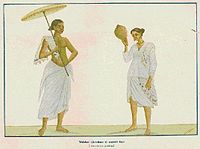
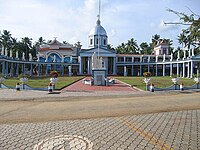
![Stained glass window of Saint Thomas the Apostle, the traditional founder of Indian Christianity, in his namesake St. Thomas CNI church, the 300 year old Cathedral of Mumbai[65]](http://upload.wikimedia.org/wikipedia/commons/thumb/c/ce/St.Thomas_Cathedral_-_Mumbai.jpg/200px-St.Thomas_Cathedral_-_Mumbai.jpg)

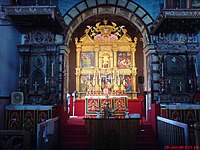


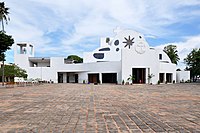



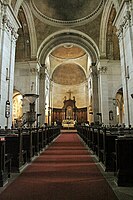
![Built in 1562, Se Cathedral is an example of the Portuguese-Manueline style of architecture.[156][157]](http://upload.wikimedia.org/wikipedia/commons/thumb/7/72/Se%E2%80%99_Cathedral%2C_Goa.jpg/200px-Se%E2%80%99_Cathedral%2C_Goa.jpg)
![St. Paul's CNI Cathedral, Calcutta is one of the finest examples of Gothic Revival architecture in India.[158]](http://upload.wikimedia.org/wikipedia/commons/thumb/c/cc/St_Paul%27s_Cathedral%2C_Kolkata.jpg/200px-St_Paul%27s_Cathedral%2C_Kolkata.jpg)
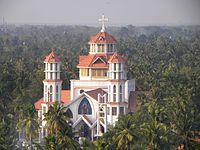
![St. Mark's Cathedral, Bangalore is an example of the English Baroque style in India.[159][160]](http://upload.wikimedia.org/wikipedia/commons/thumb/b/bc/St._Marks_Cathedral%2C_Bangalore._%28Old_Postcard_Re-print%29%2C_India_Post_%282014%29.jpg/200px-St._Marks_Cathedral%2C_Bangalore._%28Old_Postcard_Re-print%29%2C_India_Post_%282014%29.jpg)
![Church of South India Cathedral of St. George, Chennai is an example of the Neoclassical style .[161]](http://upload.wikimedia.org/wikipedia/commons/thumb/d/d2/George%27sCathedral.jpg/200px-George%27sCathedral.jpg)
![The Gothic Revival style Medak Cathedral is one of the largest churches in Asia.[162]](http://upload.wikimedia.org/wikipedia/commons/thumb/0/0a/Medak_Cathedral_%281%29.jpg/200px-Medak_Cathedral_%281%29.jpg)
![The Gothic Revival style All Saints Cathedral, Allahabad illuminated at night.[163]](http://upload.wikimedia.org/wikipedia/commons/thumb/2/21/All_Saints_Cathedral%2C_Allahabad_in_the_night.jpg/200px-All_Saints_Cathedral%2C_Allahabad_in_the_night.jpg)
![Buff-coloured basalt and limestone doorway to the CNI Afghan Church.[164]](http://upload.wikimedia.org/wikipedia/commons/thumb/f/fc/Afghan_Church_-_Doorway.jpg/200px-Afghan_Church_-_Doorway.jpg)

![St. James' Church, Delhi, built on a Greek cruciform plan is an example of the Renaissance Revival style in India.[165]](http://upload.wikimedia.org/wikipedia/commons/thumb/8/84/St._James_Church_9.jpg/200px-St._James_Church_9.jpg)